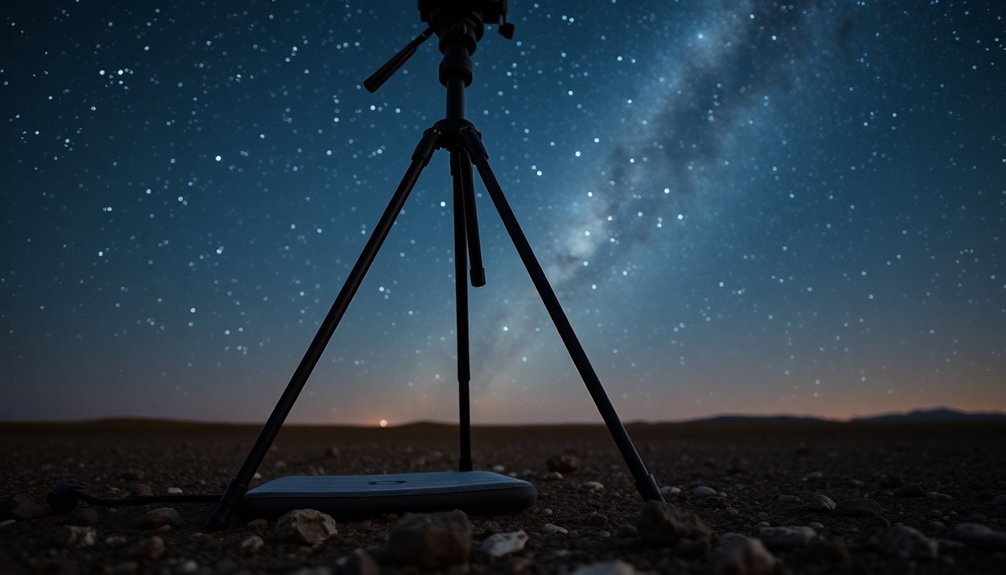For stable stargazing, implement these tripod anti-vibration methods: First, use specialized anti-vibration pads made from Sorbothane or visco-elastic rubber under each tripod leg. Second, add counterweights to your setup with hooks or weight systems to improve balance and reduce movement. Third, prepare your ground surface carefully—seek hard-packed dirt or concrete away from foot traffic. These techniques will transform your wobbly viewing sessions into crystal-clear celestial experiences when properly executed.
Anti-Vibration Pads: The Ultimate Tripod Stability Solution

When vibrations threaten to ruin your stargazing experience, anti-vibration pads emerge as the essential solution for any serious astronomer. Made primarily from plastic and silicone, with high-end options featuring visco-elastic rubber or Sorbothane, these pads effectively dampen unwanted movement from wind or footsteps.
You'll appreciate how these pads enhance stability by providing wider surface area, preventing tripods from sinking into soft ground while keeping feet clean. The Astromania Anti-vibration Suppression Pads come in sets of 3 designed specifically for each tripod leg. They'll markedly reduce settling time after touching your equipment—crucial for both visual observations and astrophotography.
Most pads work seamlessly with standard tripod feet without removing existing rubber tips. Popular options include Celestron Vibration Suppression Pads and Orion RockStable II, though DIY alternatives using 3D-printed TPA offer cost-effective solutions.
Whichever you choose, you'll immediately notice sharper, steadier views of celestial objects.
Weight Systems and Tripod Stabilizers for Rock-Steady Imaging
Three essential systems can transform your wobbly tripod into a rock-steady imaging platform.
First, utilize counterweights properly—they're vital for balancing telescopes on tracking mounts, reducing strain during long-exposure astrophotography and improving overall stability.
Counterweights aren't optional extras—they're the unsung heroes behind every sharp celestial image captured on tracking mounts.
Second, employ tripod stabilizers strategically. Screw-in anchors or ratchet straps secure your setup to the ground, while rigid center spreaders and rubber feet enhance traction on varied surfaces. Regular maintenance checks help ensure these components remain in optimal working condition, preventing stability issues before they arise.
For uneven terrain, adjustable legs and stabilizing jacks like the BAL Kingpin Fast Jack provide independent adjustments.
Finally, accessorize intelligently. Add weight hooks to your center column for even weight distribution, and use bungee cords with anchors during windy conditions.
Remember to minimize center column extension whenever possible—this simple technique considerably reduces unwanted vibrations.
Ground Preparation Techniques for Vibration-Free Stargazing

Proper ground preparation serves as the foundation for exceptional stargazing experiences. Before setting up your tripod, verify you're working with level, compacted soil in an area free from debris and moisture. This simple step dramatically reduces unwanted vibrations that can blur your celestial observations. Clear, moonless nights provide ideal conditions for detailed views of celestial objects when your equipment is properly stabilized.
| Surface Type | Stability Rating | Best For | Preparation Needed |
|---|---|---|---|
| Hard-packed dirt | Excellent | All equipment | Minimal clearing |
| Concrete/asphalt | Superior | Heavy telescopes | None |
| Grassy field | Fair | Portable setups | Compaction required |
| Rocky terrain | Poor | Emergency use only | Extensive leveling |
Choose elevated locations with minimal light pollution and unobstructed sky views. Remember to limit foot traffic around your setup area and position yourself away from wildlife paths to maintain vibration-free observations throughout your stargazing session.
Frequently Asked Questions
Can Homemade Anti-Vibration Solutions Match Commercial Products?
No, your homemade anti-vibration solutions typically can't match commercial products for consistency and performance with critical applications, though they're cost-effective and may suffice for basic needs with proper materials like Sorbothane.
How Do Temperature Changes Affect Vibration Dampening Materials?
Temperature changes greatly impact your vibration dampening materials. Cold makes them stiffer with higher resonance frequencies, while heat softens them. Materials like neoprene and EPDM maintain effectiveness across wider temperature ranges than others.
Are Wireless Remote Triggers Better Than Wired for Reducing Vibrations?
Yes, wireless triggers are better for reducing vibrations as they eliminate the physical connection that can transfer movement. You won't risk bumping cables during long exposures, giving you cleaner stargazing shots.
What Maintenance Do Anti-Vibration Pads Require for Long-Term Effectiveness?
You'll need minimal maintenance for anti-vibration pads. Simply clean them regularly to remove dirt, store in dry places, inspect for wear, and replace when they lose elasticity. Don't expose them to harsh chemicals.
How Do Anti-Vibration Methods Differ for Tracking Mounts Versus Fixed Tripods?
Tracking mounts need specialized anti-vibration solutions due to their continuous motion, while fixed tripods use simpler pads. You'll find tracking setups require more precise dampening to maintain accuracy during celestial tracking.
In Summary
You'll notice an immediate improvement in your stargazing experience by implementing these anti-vibration methods. Whether you're using stability pads, adding weight to your setup, or taking time to prepare your ground surface, each technique greatly reduces unwanted movement. Don't let vibrations ruin your celestial observations—apply these practical solutions and you'll capture sharper images and enjoy more detailed views of the night sky.





Leave a Reply